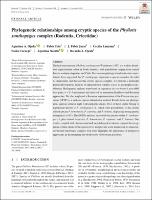Phylogenetic relationships among cryptic species of the phyllotis xanthopygus complex (rodentia, cricetidae)
Date
2021-01-12Author
Ojeda, Agustina Alejandra
Teta, Pablo Vicente
Jayat, Jorge Pablo
Lanzone, Cecilia
Cornejo, Paula
Novillo, Agustina
Ojeda, Ricardo Alberto
Metadata
Show full item recordAbstract
The leaf-eared mouse, Phyllotis xanthopygus (Waterhouse 1837) is a widely distributed sigmodontine rodent in South America, with populations ranging from central Peru to southern Argentina and Chile. Previous morphological and molecular contributions have suggested that P. xanthopygus represents a species complex. In order to characterize and disclose this cryptic species complex, we perform a molecular genetic/phylogenetic analysis of representative samples across its geographical distribution. Phylogenetic analyses were based on sequences of cytochrome-b gene (801 base pairs; n = 114 specimens) and analysed by maximum likelihood and Bayesian approaches. We also employed a Bayesian implementation of the Poisson tree processes (bPTP) as a unilocus species delimitation method. Results from our phylogenetic analyses retrieve eight well-supported clades. Five of these clades belong to populations known as P. xanthopygus s.l., which were paraphyletic to the closely
related species P. bonariensis, P. caprinus, and P. limatus, displaying strong genetic divergences (>8%). The (bPTP) analyses recovered ten species within P. xanthopygus s.l. plus related forms (i.e. P. bonariensis, P. caprinus, and P. limatus). Our results, coupled with chromosomal and morphological evidences, support the recognition of these clades at the species level and provide a new framework to characterize the leaf-eared mice complex. Our study highlights the importance of integrative approaches in disentangling the biodiversity of Neotropical rodents.
Collections
The following license files are associated with this item:



